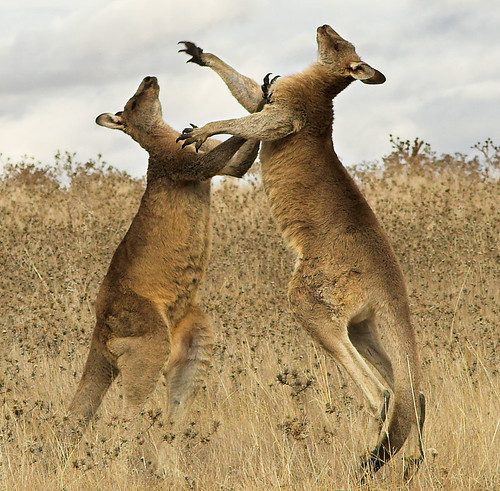 The kangaroo is a national symbol of Australia: its emblem is used on the Australian coat of arms, on some of its currency, as well as by some of Australia's best known organisations, including Qantas The kangaroo is important to both Australian culture and the national image and consequently there are numerous popular culture references
The kangaroo is a national symbol of Australia: its emblem is used on the Australian coat of arms, on some of its currency, as well as by some of Australia's best known organisations, including Qantas The kangaroo is important to both Australian culture and the national image and consequently there are numerous popular culture referencesKangaroos are the only large animals to use hopping as a means of locomotion. The comfortable hopping speed for Red Kangaroo is about 20–25 km/h (13–16 mph), but speeds of up to 70 km/h (44 mph) can be attained, over short distances, while it can sustain a speed of 40 km/h (25 mph) for nearly 2 kilometres (1.2 mi). This fast and energy-efficient method of travel has evolved because of the need to regularly cover large distances in search of food and water, rather than the need to escape predators.To move at slow speeds, it uses its tail to form a tripod with its two forelimbs it then raises its hind feet forward.
Fighting has been described in all species of kangaroo. Fights between kangaroos can be brief or long and ritualised. In highly competitive situations such as males fighting for access to oestrous females or at limited drinking spots, the fights are brief. Both sexes will fight for drinking spots, but long ritualised fighting or "boxing" is largely done by males. Smaller males fight more often near females in estrus while the large males in consorts do not seem to get involved. Ritualised fights can arise suddenly when males are grazing together. However, most fights are preceded by two males scratching and grooming each other. One or both of them will adopt a high standing posture, with one male issuing a challenge by grasping the other male’s neck with its forepaw. Sometimes the challenge will be declined. Large males often reject challenges by smaller males. During fighting, the combatants adopt a high standing posture and paw at each other's heads, shoulders and chests. They will also lock forearms and wrestle and push each other as well balance on their tails to kick each other in the abdomens


No comments:
Post a Comment